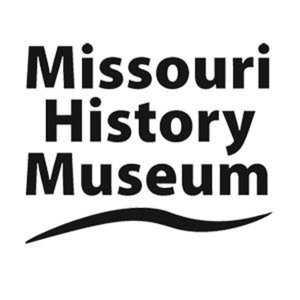from Apr. 16, 1865
Abigail Williams May to Eleanor Goddard May
-
Full Title
Abigail Williams May to Eleanor Goddard May
-
Description
Abigail Williams May reflected on the wider significance of the two days since President Lincoln's assassination, saying, “You will remember, forever, with satisfaction, that you were alive at this time.”
-
Source
May and Goddard Family Papers, Schlesinger Library on the History of Women in America, Radcliffe Institute for Advanced Study, Harvard University, Cambridge, MA
-
Rights
Use of this item for research, teaching, and private study is permitted with proper citation and attribution. Reproduction of this item for publication, broadcast, or commercial use requires written permission.
-
Tags
-
Cite this Item
Abigail Williams May. "Abigail Williams May to Eleanor Goddard May". Remembering Lincoln. Web. Accessed December 15, 2025. https://rememberinglincoln.fords.org/node/693
-
Creator
Abigail Williams May
-
Date
April 16, 1865
from Apr. 16, 1865
Abigail Williams May to Eleanor Goddard May
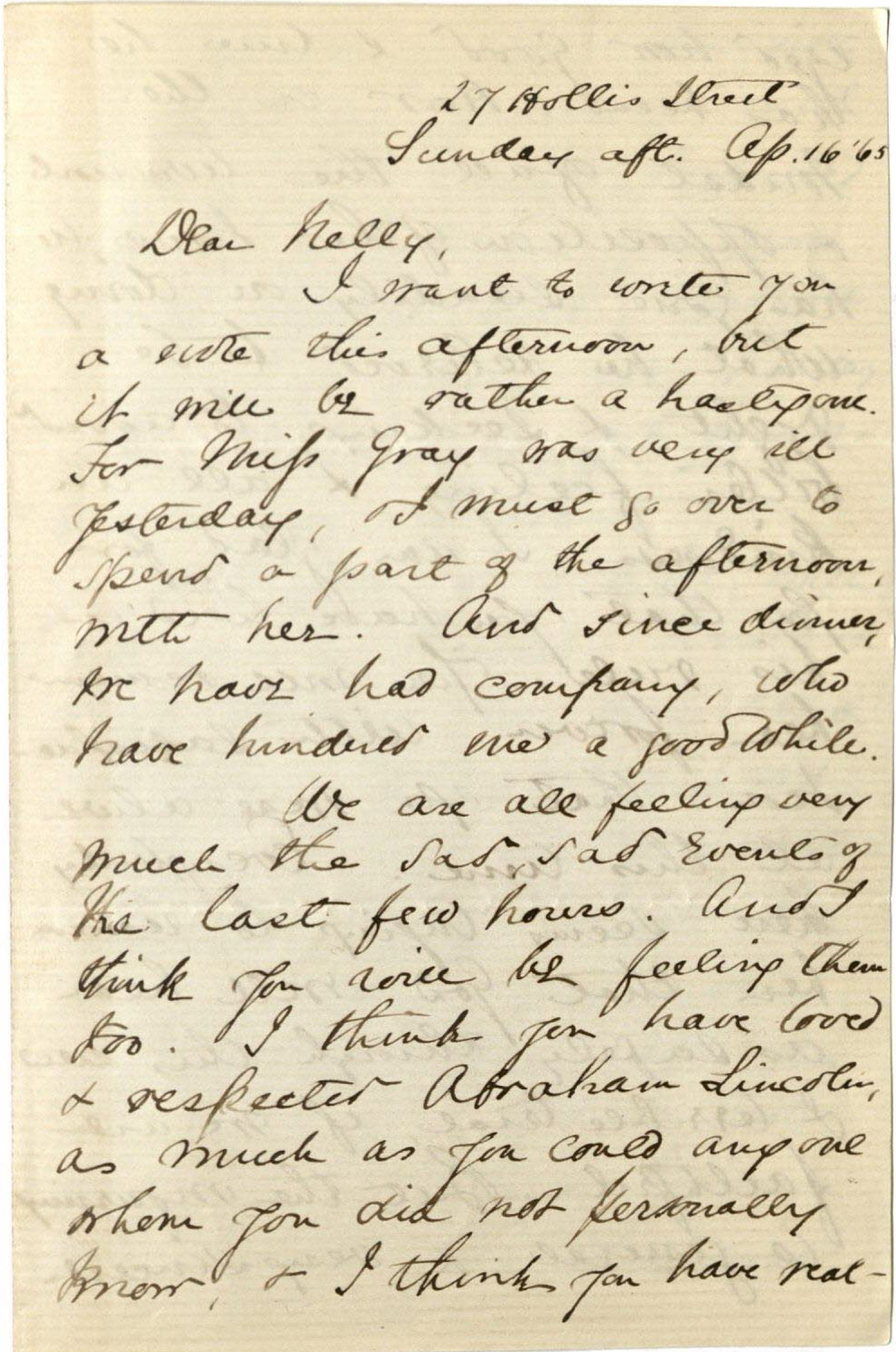
-
Description
Abigail Williams May reflected on the wider significance of the two days since President Lincoln's assassination, saying, “You will remember, forever, with satisfaction, that you were alive at this time.”
-
Source
May and Goddard Family Papers, Schlesinger Library on the History of Women in America, Radcliffe Institute for Advanced Study, Harvard University, Cambridge, MA
-
Rights
Use of this item for research, teaching, and private study is permitted with proper citation and attribution. Reproduction of this item for publication, broadcast, or commercial use requires written permission.
-
Creator
Abigail Williams May
-
Date
April 16, 1865
from Apr. 22, 1865
Mourning Ribbon, Philadelphia Services
-
Full Title
Mourning ribbon for services in honor of Lincoln in Philadelphia.
-
Description
Red, blue, white, and black cloth ribbon with framed photographic portrait of Lincoln at center and cared attached above reading: "Obsequies of Abraham Lincoln, Late President of the United States, Philadelphia, April 22nd 1865, at the Hall of Independence from 10 to 12 o'clock P.M. Entrance at the Court House, on Sixth below Chestnut Street.
-
Source
-
Rights
This item is in the Public Domain.
-
Tags
-
Cite this Item
Unknown. "Mourning ribbon for services in honor of Lincoln in Philadelphia. ". Remembering Lincoln. Web. Accessed December 15, 2025. https://rememberinglincoln.fords.org/node/688
-
Creator
Unknown
-
Date
April 22, 1865
from Apr. 22, 1865
Mourning ribbon for services in honor of Lincoln in Philadelphia.
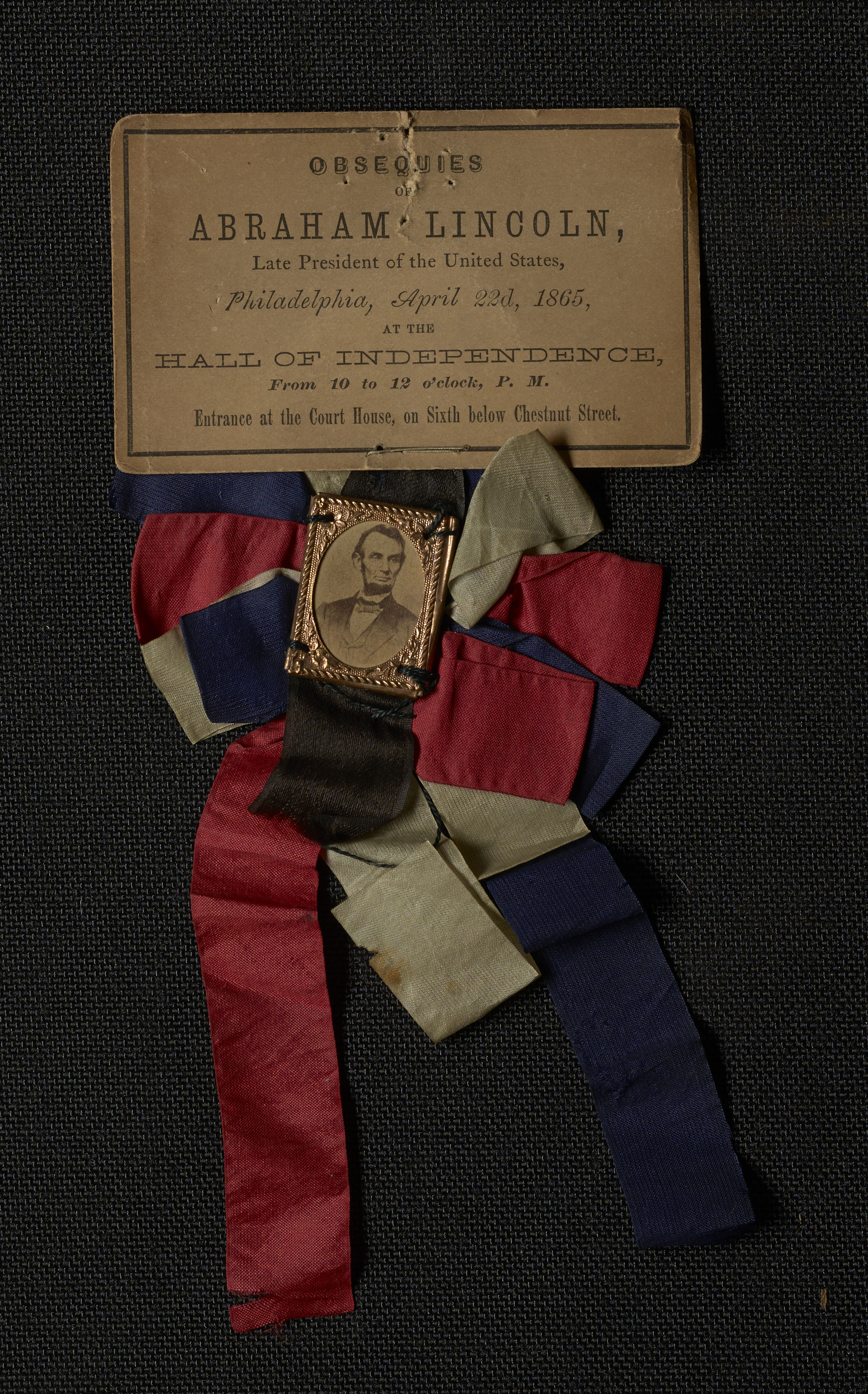
-
Description
Red, blue, white, and black cloth ribbon with framed photographic portrait of Lincoln at center and cared attached above reading: "Obsequies of Abraham Lincoln, Late President of the United States, Philadelphia, April 22nd 1865, at the Hall of Independence from 10 to 12 o'clock P.M. Entrance at the Court House, on Sixth below Chestnut Street.
-
Source
-
Rights
This item is in the Public Domain.
-
Creator
Unknown
-
Date
April 22, 1865
from Apr. 30, 1865
Mourning Ribbon/Badge
-
Full Title
Mourning Ribbon/Badge
-
Description
Cloth mourning badge or ribbon with portrait of Lincoln and the text "Assassinated at Washington 14 April 1865. I have said nothing but what I am willing to live by, and if it be the pleasure of almighty God to die by. (A Lincoln)" [and under the portrait] "The Late Lamented President Lincoln"
-
Source
-
Rights
This item is in the Public Domain.
-
Tags
-
Cite this Item
Unknown. "Mourning Ribbon/Badge". Remembering Lincoln. Web. Accessed December 15, 2025. https://rememberinglincoln.fords.org/node/687
-
Creator
Unknown
-
Date
1865
from Apr. 30, 1865
Mourning Ribbon/Badge

-
Description
Cloth mourning badge or ribbon with portrait of Lincoln and the text "Assassinated at Washington 14 April 1865. I have said nothing but what I am willing to live by, and if it be the pleasure of almighty God to die by. (A Lincoln)" [and under the portrait] "The Late Lamented President Lincoln"
-
Source
-
Rights
This item is in the Public Domain.
-
Creator
Unknown
-
Date
April 30, 1865
from Apr. 20, 1865
Mourning Ribbon
-
Full Title
Mourning Ribbon
-
Description
Cloth mourning ribbon with printed text, mounted on sheet with date written in manuscript. The text reads "In Memory of our President." "Lincoln to day is first in the hearts of his countrymen."
-
Source
-
Rights
This item is in the Public Domain.
-
Tags
-
Cite this Item
Unknown. "Mourning Ribbon". Remembering Lincoln. Web. Accessed December 15, 2025. https://rememberinglincoln.fords.org/node/686
-
Creator
Unknown
-
Date
April 20, 1865
from Apr. 20, 1865
Mourning Ribbon
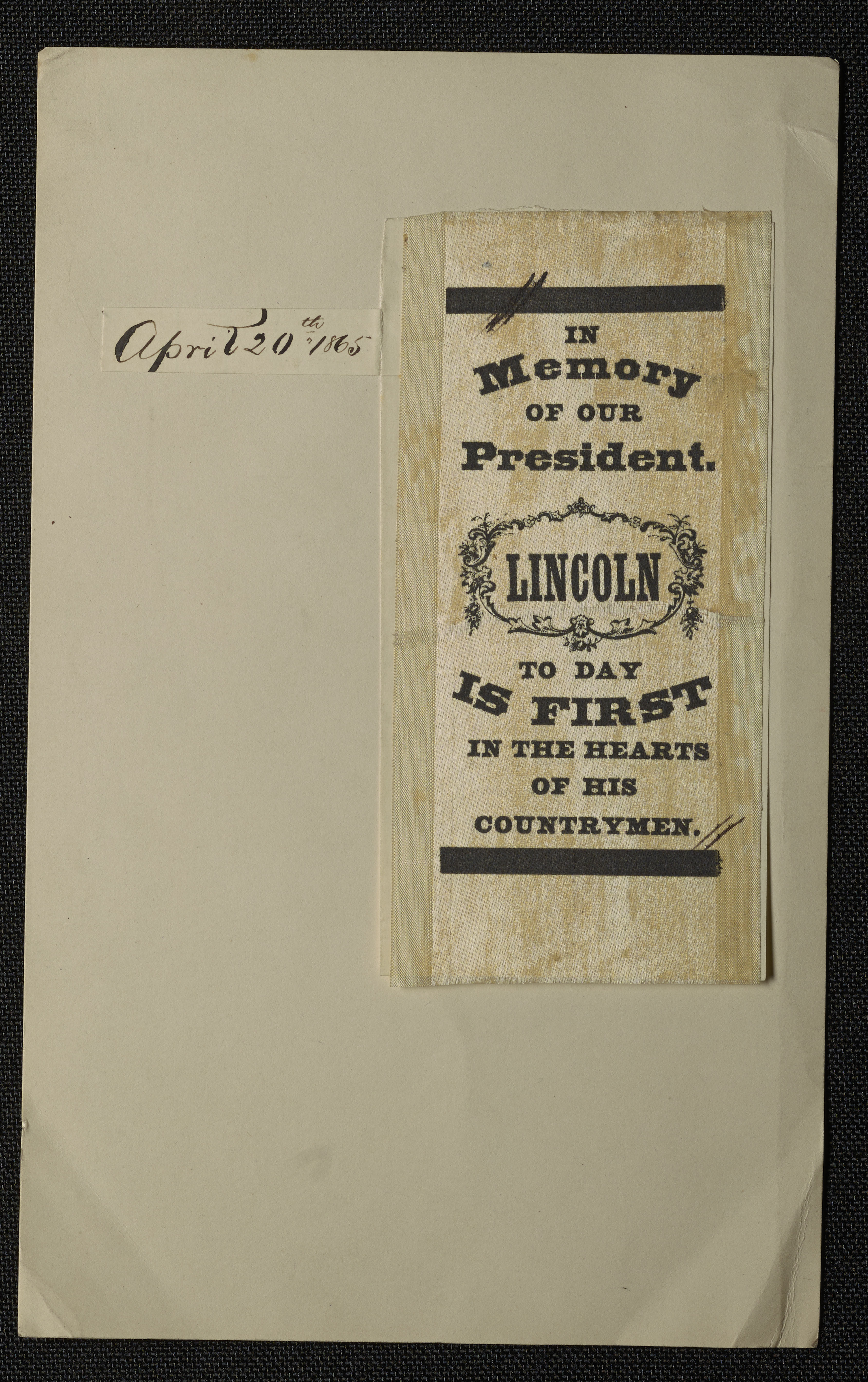
-
Description
Cloth mourning ribbon with printed text, mounted on sheet with date written in manuscript. The text reads "In Memory of our President." "Lincoln to day is first in the hearts of his countrymen."
-
Source
-
Rights
This item is in the Public Domain.
-
Creator
Unknown
-
Date
April 20, 1865
from May. 1, 1865
Small Mourning Ribbon with Photograph of Lincoln
-
Full Title
Small Mourning Ribbon with Photograph of Lincoln
-
Description
A black mourning ribbon with small framed photographic portrait of Lincoln at the center.
-
Source
-
Rights
This item is in the Public Domain.
-
Tags
-
Cite this Item
Unknown. "Small Mourning Ribbon with Photograph of Lincoln". Remembering Lincoln. Web. Accessed December 15, 2025. https://rememberinglincoln.fords.org/node/685
-
Creator
Unknown
-
Date
1865
from May. 1, 1865
Small Mourning Ribbon with Photograph of Lincoln
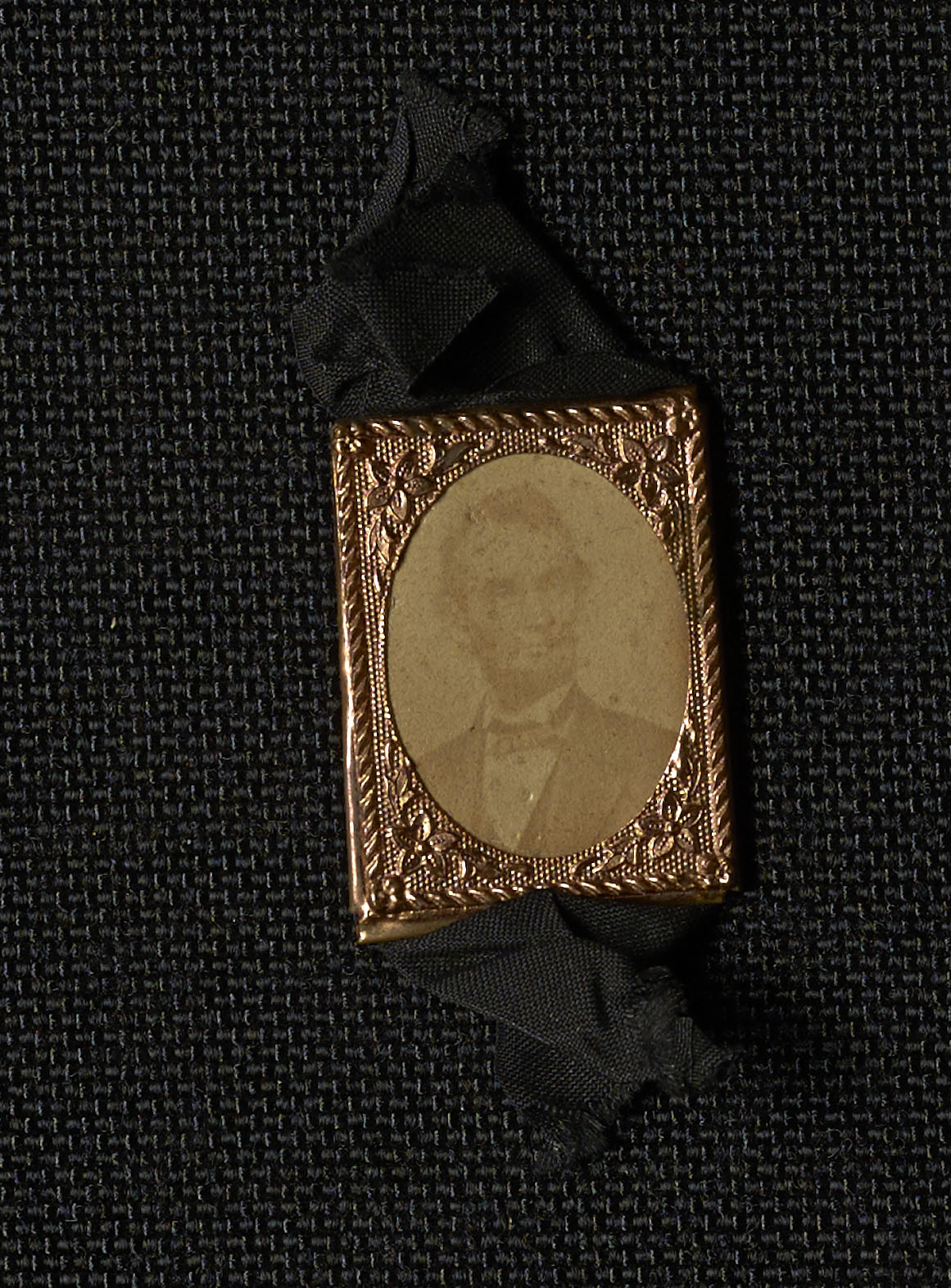
-
Description
A black mourning ribbon with small framed photographic portrait of Lincoln at the center.
-
Source
-
Rights
This item is in the Public Domain.
-
Creator
Unknown
-
Date
May 1, 1865
from Apr. 30, 1865
Mourning Card in Memory of Lincoln
-
Full Title
Mourning Card in Memory of Lincoln
-
Description
Mourning card with embossed tombstone and a quote from Lincoln's second inaugural address.
-
Source
-
Rights
This item is in the Public Domain.
-
Tags
-
Cite this Item
Unknown. "Mourning Card in Memory of Lincoln". Remembering Lincoln. Web. Accessed December 15, 2025. https://rememberinglincoln.fords.org/node/684
-
Creator
Unknown
-
Date
1865
from Apr. 30, 1865
Mourning Card in Memory of Lincoln
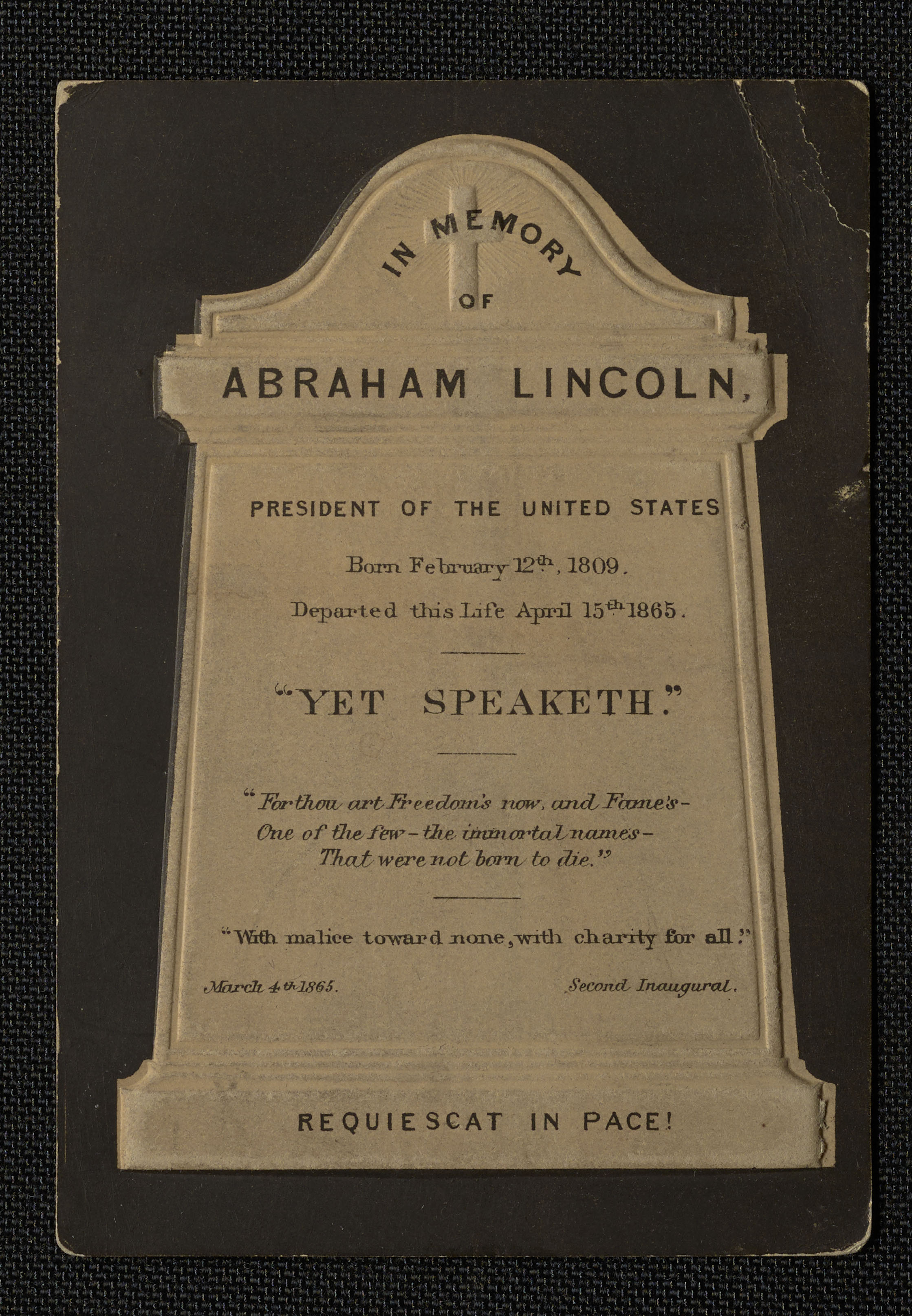
-
Description
Mourning card with embossed tombstone and a quote from Lincoln's second inaugural address.
-
Source
-
Rights
This item is in the Public Domain.
-
Creator
Unknown
-
Date
April 30, 1865
from May. 1, 1865
Mourning Envelope with Portrait of Lincoln
-
Full Title
Mourning Envelope with Portrait of Lincoln
-
Description
An envelope bearing the phrase "We mourn a father slain" and a black-bordered portrait of Lincoln.
-
Source
-
Rights
This item is in the Public Domain.
-
Tags
-
Cite this Item
Unknown. "Mourning Envelope with Portrait of Lincoln". Remembering Lincoln. Web. Accessed December 15, 2025. https://rememberinglincoln.fords.org/node/683
-
Creator
Unknown
-
Date
1865
-
Material
Envelope
from May. 1, 1865
Mourning Envelope with Portrait of Lincoln
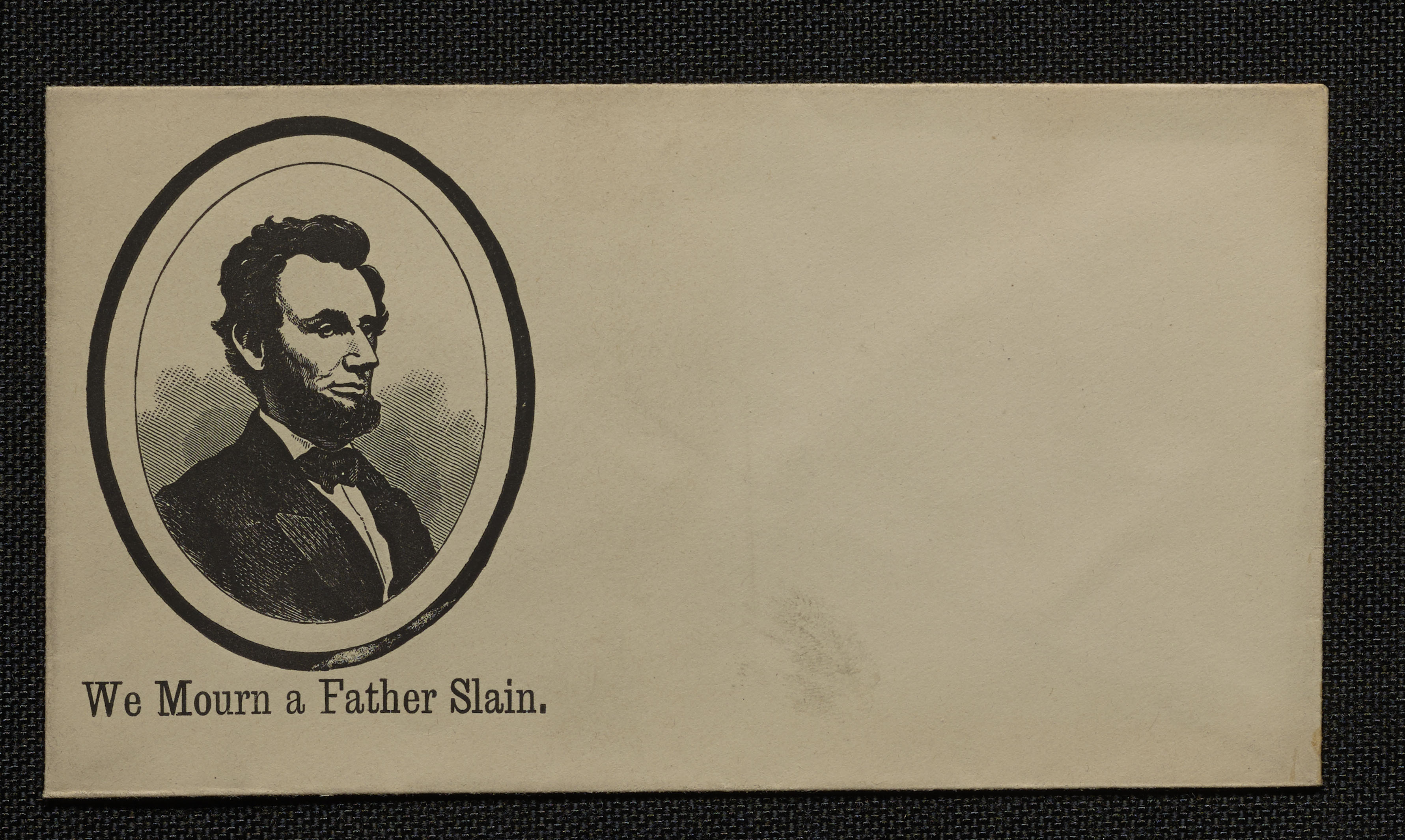
-
Description
An envelope bearing the phrase "We mourn a father slain" and a black-bordered portrait of Lincoln.
-
Source
-
Rights
This item is in the Public Domain.
-
Creator
Unknown
-
Date
May 1, 1865
-
Material
Envelope
from Apr. 17, 1865
Telegram of J.M. Berrien, April 17, 1865
-
Full Title
Contemporary copy of telegram of J.M. Berrien, Commandant Naval Station, Norfolk, to The Honorable Gideon Welles, Secretary of the Navy, Washington, D.C., April 17, 1865
-
Description
States, "Telegram of yesterday ordering a gun to be fired every half hour during this day, received at Six, forty five (6.45') A.M. to day. . . ." Refers to orders for the day of Abraham Lincoln's funeral.
-
Rights
This item is in the public domain.
-
Tags
-
Cite this Item
Berrien, J. M.. "Contemporary copy of telegram of J.M. Berrien, Commandant Naval Station, Norfolk, to The Honorable Gideon Welles, Secretary of the Navy, Washington, D.C., April 17, 1865". . Remembering Lincoln. Web. Accessed December 15, 2025. https://rememberinglincoln.fords.org/node/641
from Apr. 17, 1865
Contemporary copy of telegram of J.M. Berrien, Commandant Naval Station, Norfolk, to The Honorable Gideon Welles, Secretary of the Navy, Washington, D.C., April 17, 1865
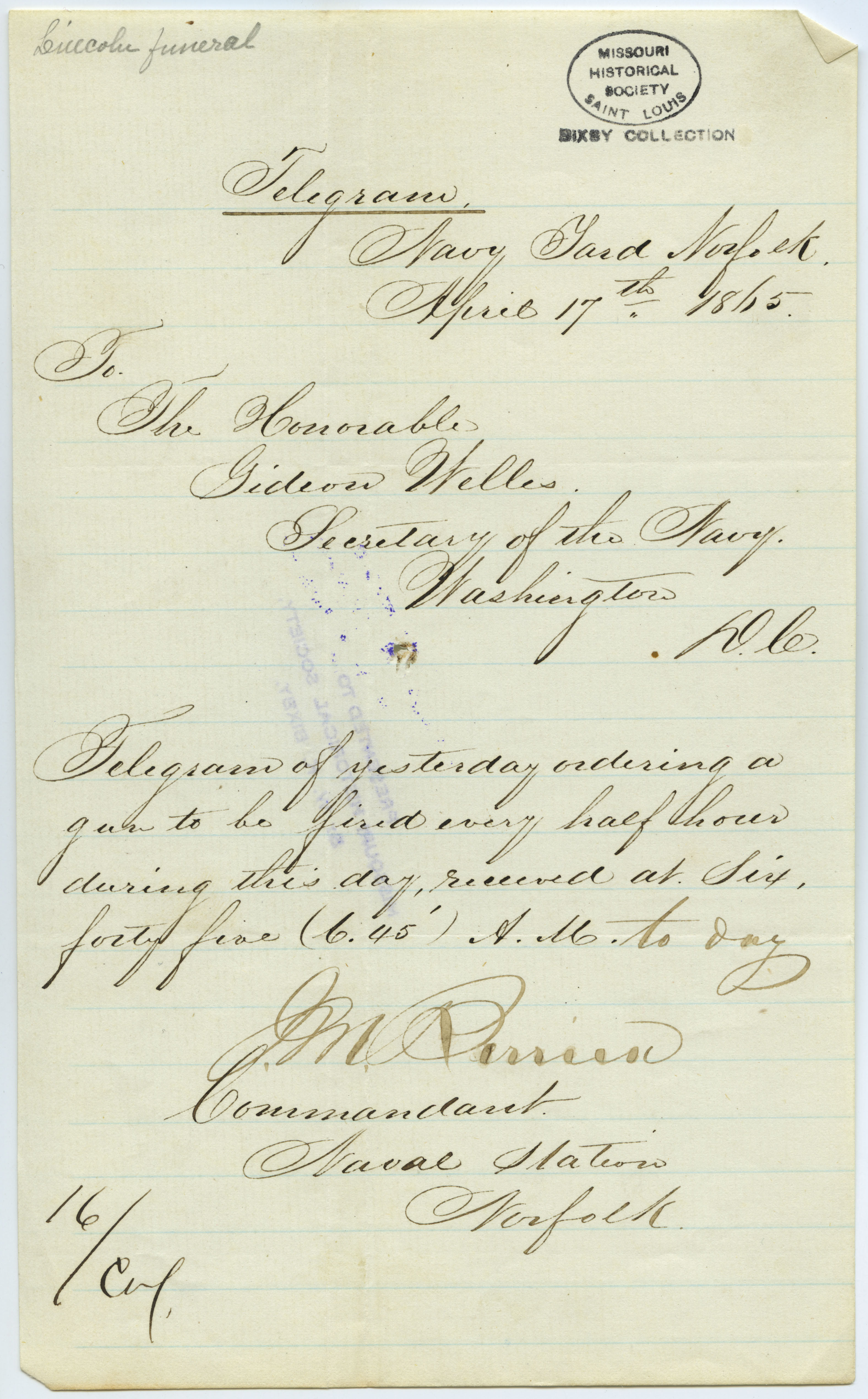
-
Description
States, "Telegram of yesterday ordering a gun to be fired every half hour during this day, received at Six, forty five (6.45') A.M. to day. . . ." Refers to orders for the day of Abraham Lincoln's funeral.
-
Rights
This item is in the public domain.
-
Creator
Berrien, J. M.
-
Publisher
-
Date
April 17, 1865
-
Material
from Apr. 17, 1865
Telegram of Gideon Welles, April 17, 1865
-
Full Title
Contemporary copy of telegram of Gideon Welles, Secretary of the Navy, to Commodore Wm. Radford [William Radford] U.S.N., U.S.S. "Phlox", Hampton Roads, April 17, 1865
-
Description
Contains orders for all naval vessels on the day of Abraham Lincoln's funeral.
-
Transcription
Telegram.
To Commodore Wm. Redford U.S.N.
U.S.S. “Phlox.” Hampton Roads.
The following telegram was received last night.
Special Order.
Navy Department
Washington. April 17, 1865
To Rear Admiral
D.D. Porter Commdr N.A. Squadron
By order of the President of the United States, the Navy Department will be closed on Wednesday next, the day of the funeral solemnities of the late President of the United States. Labor will also be suspended on that day at each of the Navy Yards and Naval Stations and upon all the vessels of the United States. The flags of all vessels, and at all the Navy Yards and stations, and Marine Barracks, will be kept at half mast during the day, and at 12 o’clock meridian twenty one (21) minute guns will be fired by the Senior Officer of each Squadron and the Commandants of each of the Navy Yards and Stations.
Gideon Welles
Secretary of the Navy
Copies sent above and below
K. R. Breese
Fleet Captain
Transcription Team:
Sarah D., Ashlynn T., Pamela N.
New Hampton Middle School, New Hampton, Iowa
-
Rights
This item is in the public domain.
-
Tags
-
Cite this Item
Welles, Gideon, 1802-1878. "Contemporary copy of telegram of Gideon Welles, Secretary of the Navy, to Commodore Wm. Radford [William Radford] U.S.N., U.S.S. "Phlox", Hampton Roads, April 17, 1865". . Remembering Lincoln. Web. Accessed December 15, 2025. https://rememberinglincoln.fords.org/node/640
from Apr. 17, 1865
Contemporary copy of telegram of Gideon Welles, Secretary of the Navy, to Commodore Wm. Radford [William Radford] U.S.N., U.S.S. "Phlox", Hampton Roads, April 17, 1865
![Contemporary copy of telegram of Gideon Welles, Secretary of the Navy, to Commodore Wm. Radford [William Radford] U.S.N., U.S.S.](https://rememberinglincoln.fords.org/sites/default/files/190-Gideon%20Welles%20Telegram%2C%20page%201.jpg)
-
Description
Contains orders for all naval vessels on the day of Abraham Lincoln's funeral.
-
Rights
This item is in the public domain.
-
Creator
Welles, Gideon, 1802-1878
-
Publisher
-
Date
April 17, 1865
-
Material
from Apr. 17, 1865
Military Telegraph of R. O'Brien, April 17, 1865
-
Full Title
United States Military Telegraph of R. O'Brien, Goldsboro, to Genl. Dodge, April 17, 1865
-
Description
States that President Lincoln was assassinated on the night of the 14th while in his box at Ford's Theater. Gives details of the night, including the attack on Seward, and asks that Dodge not make the information public at the present time.
-
Transcription
United States Military Telegraph.
By Telegraph from Goldsboro
Dated April 17, 1865
To Genl. Dodge
Genl,
I regret to have to
tell you that president Lincoln
was assassinated on the night of
14th while in his box at Fords
Theatre. The assassin shot him
through the head and leaped out
of the box brandishing a dagger
and shouting Sic Simfor Tirrannis,
The president lived about 2 hours,
at the same time an assassin
entered Secy Sewards house and stabbed
him several times it is hoped he
will recover but his son Fredrick
was mortally wounded, Do not
make this justice for present.
R. O’Brian
[Transcription Team: Kara C., Avery T., Austin G., Madison R., Tyler S.]
[New Hampton Middle School] -
Rights
This item is in the public domain.
-
Tags
-
Cite this Item
O'Brien, R.. "United States Military Telegraph of R. O'Brien, Goldsboro, to Genl. Dodge, April 17, 1865". . Remembering Lincoln. Web. Accessed December 15, 2025. https://rememberinglincoln.fords.org/node/636
from Apr. 17, 1865
United States Military Telegraph of R. O'Brien, Goldsboro, to Genl. Dodge, April 17, 1865
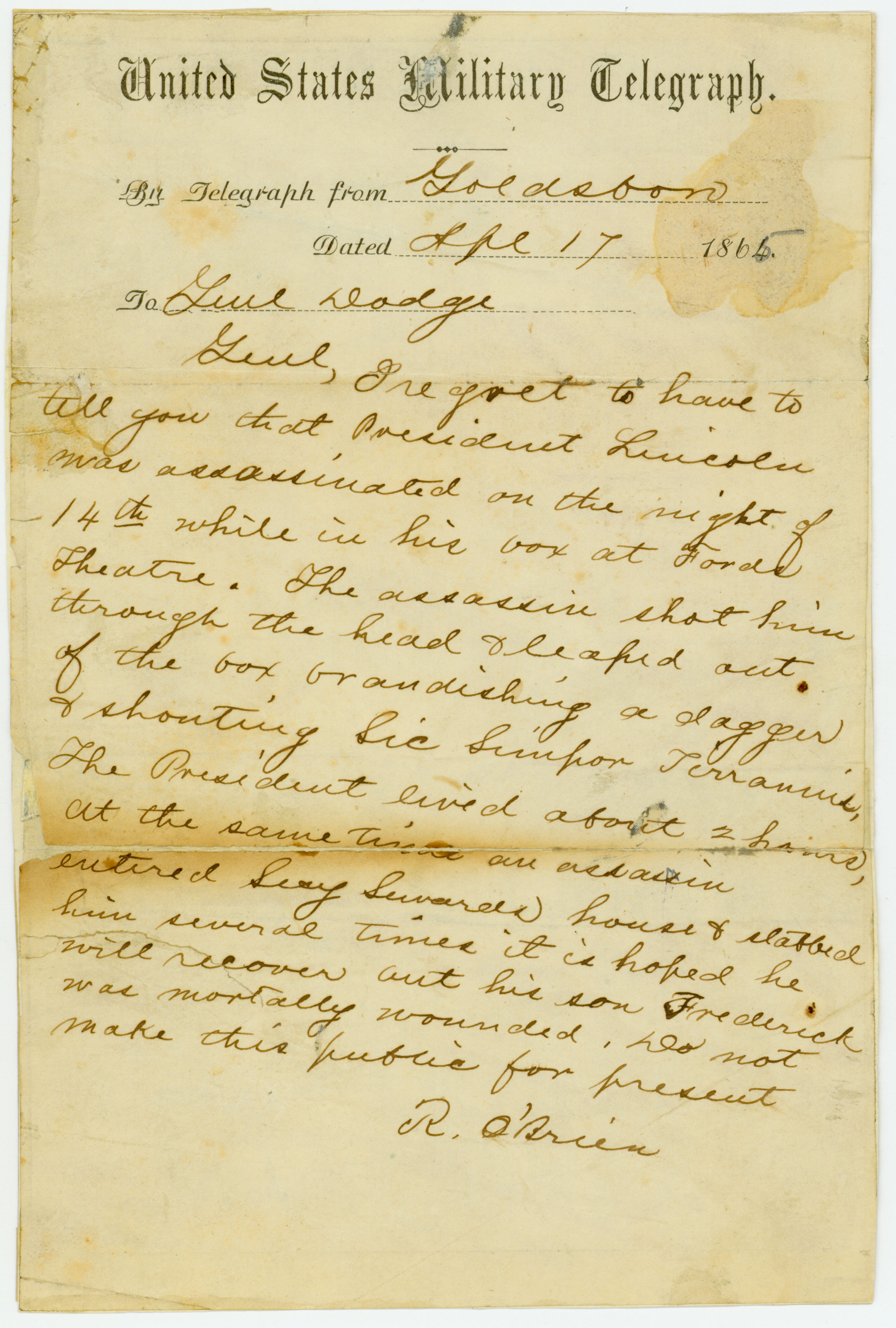
-
Description
States that President Lincoln was assassinated on the night of the 14th while in his box at Ford's Theater. Gives details of the night, including the attack on Seward, and asks that Dodge not make the information public at the present time.
-
Rights
This item is in the public domain.
-
Creator
O'Brien, R.
-
Publisher
-
Date
April 17, 1865
-
Material
